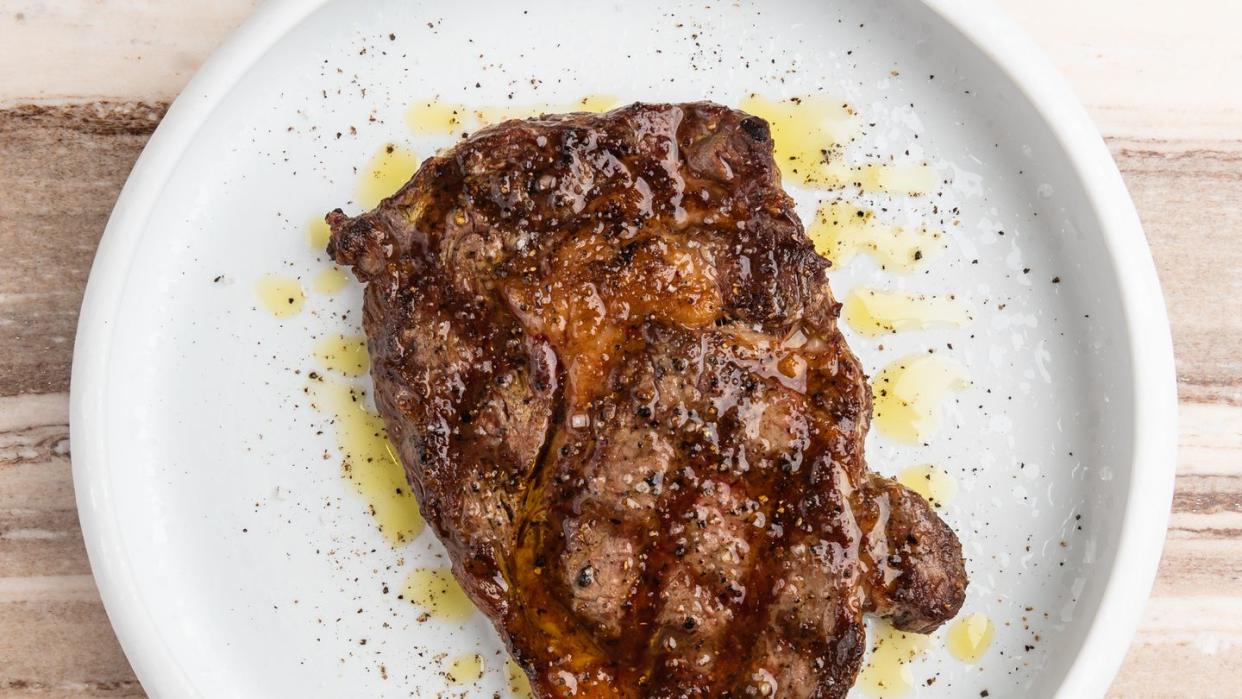

“Hearst Magazines and Yahoo may earn commission or revenue on some items through these links.”
[table-of-contents] stripped
Every diet has a slightly different goal, whether it’s to help you lose weight, improve your overall health, lower bodily inflammation, or do something else entirely. The vertical diet is designed to help improve your body composition, and tends to attract people who want to bulk up.
Meet the experts: Scott Keatley, R.D., is co-owner of Keatley Medical Nutrition Therapy; Albert Matheny, R.D., C.S.C.S., is co-founder of SoHo Strength Lab and advisor to Promix Nutrition; Jessica Cording, R.D., is the author of The Little Book of Game-Changers.
But what is the vertical diet and who can benefit from it? Nutritionists break it down.
What is the vertical diet?
The vertical diet is an eating plan created by professional bodybuilder Stan Efferding. He wrote a book called The Vertical Diet: A Simple, Sensible, and Sustainable Lifestyle Plan to Improve Body Composition for Optimal Health and Performance along with Damon McCune, Ph.D., R.D. The book lays the foundation for an eating program “that sets the confusion aside and puts you on the path to weight loss, better performance, and overall better health,” according to its Amazon description.
The diet has been promoted by a slew of people, including Hafthor Bjornsson (who played “The Mountain” on Game of Thrones) and Philadelphia Eagles player Lane Johnson. It focuses on eating nutrient-dense foods that are easy to digest.
Efferding’s website says that the diet aims to enhance metabolism and overall digestive health. “The fundamental principles of the vertical diet can and should be used to improve and optimize ANY diet program,” the website reads.
But the diet has a lot of restrictions. “The idea behind the vertical diet is to limit food variety in order to increase absorption of nutrients,” says Scott Keatley, R.D., co-owner of Keatley Medical Nutrition Therapy.
Efferding also has a vertical diet food delivery service, which includes programs tailored to help followers build muscle, lose weight, or customize their meals based on their goals.
What foods can you eat on the vertical diet?
The vertical diet is heavy on red meat and white rice, along with certain vegetables, full-fat dairy, eggs, and some low FODMAP fruits, Keatley says. (A low FODMAP diet is typically used to help people figure out their food sensitivities.) “It emphasizes foods that are supposedly easy to digest and nutrient-dense,” Keatley says. The main components of the diet include:
-
Protein sources: Red meat, particularly lean cuts, is heavily emphasized.
-
Carbohydrates: White rice is the preferred carbohydrate source.
-
Vegetables: These are usually low FODMAP options like carrots, cucumbers, and spinach.
-
Fats: Sources are usually things like eggs and full-fat dairy.
-
Fruits: These are limited to low FODMAP choices like oranges and blueberries.
What foods can’t you eat on the vertical diet?
The diet recommends avoiding the following foods, according to Albert Matheny, R.D., C.S.C.S., co-founder of SoHo Strength Lab and advisor to Promix Nutrition:
-
Brown rice
-
Grains other than white rice
-
Most vegetable oils
-
Soy
-
Beans
-
Peanuts
-
Peas
-
Onions
-
Garlic
-
Coffee
-
Added sugar
-
Sugar alcohols
-
High FODMAP vegetables (like broccoli and cauliflower)
-
High FODMAP fruits (like apples, cherries, and pears)
What are potential health benefits of going on the vertical diet?
The potential benefits are mostly around digestion, says Jessica Cording, R.D., author of The Little Book of Game-Changers. “If somebody has an underlying gastrointestinal issue, being on a low FODMAP diet by default gives them the opportunity to eliminate things that might have been causing problems,” she says.
Matheny agrees. “This diet removes a lot of foods that often bother people’s digestion,” he says. “But people will also get on a vegan diet and talk about how great they feel. It’s often because they cut out fried chicken and other foods that can make you feel not so great.”
The diet is also high in protein, which can support muscle growth, Cording says. “Most people do not get enough protein in their day,” Matheny says. “For 90% of people in America, this diet would be an improvement over what they’re currently eating.”
Cording also likes that the diet cuts out added sugar. “That will help with health in other ways,” she says.
What are potential concerns of the vertical diet?
Experts have a few concerns about going on the vertical diet. “You’re missing a bunch of micronutrients by limiting your starch intake to just rice, especially trace minerals and some healthy fats,” Keatley says.
Both Keatley and Cording are concerned about the low amount of fiber in this diet. “That can have digestive health consequences,” Cording says. The diet is also “so limited that it can have you miss out on other nutrients,” she adds. The high red meat consumption is also concerning, Cording says: “That’s associated with an increased risk of cancer and other health issues.”
Matheny says the diet isn’t the healthiest eating plan you could choose. “I wouldn’t say that this diet is going to make your nutrition better,” he says.
The lack of variety in the diet is also concerning to Cording—it makes it less likely that someone would stick with it, she says.
The bottom line
While experts say you may lose weight on the vertical diet, they don’t necessarily recommend trying it. If you want to find ways to get more protein into your diet, Cording suggests talk to a registered dietitian for personalized advice.
Keatley agrees. “If you’re looking to improve performance, work with a sports nutrition-focused dietitian,” he says. “They can get you where you want to be with way less restriction.”
You Might Also Like
Source: aol.com




















Add comment